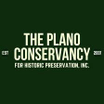Wayside Signs
Educational & Informative
Wayside Signs are a fantastic way to communicate the significance of a site's history to visitors 24/7. We work with you to write the content and design the sign's appearance.
Funded by Grants
The Plano Conservancy for Historic Preservation Inc., seeks to install new wayside signs annually with the assistance of grant funding from the City of Plano Heritage Commission.
Sites all over Plano
We select our wayside sign sites based on their historical, architectural, or cultural merit and significance. Since funding for many of the signs comes from City of Plano grants, they must be installed within Plano city limits. Alternatively funded wayside signs are also an option for locations outside of Plano.
Our Wayside Signs
Houston & Texas Central Railroad
Houston & Texas Central Railroad
Houston & Texas Central Railroad

This wayside sign is located in Downtown Plano next to the DART line to educate tourists about the history of the Houston & Texas Central rail which ran through the area.
Shawnee Trail

The Shawnee Trail was one of the famous trails of the cattle drive era. The route through Plano was close to today's Preston Road.
Wildcat Stadium (Williams Field)
Wildcat Stadium (Williams Field)

Wildcat Stadium was home of the Plano High School football team from 1964 to 1975.
Young Cemetery
Wildcat Stadium (Williams Field)
Young Cemetery

In 1847 a small cemetery was started on the Texas prairie, just south of West Rowlett Creek. Today that cemetery is landlocked by an apartment complex to the west and a golf course to the south and east. The one-acre site was set aside for family members and friends who helped settle the area near the present-day crossroads of Plano, McKinney, Frisco and Allen.
Horn Cemetery
Wildcat Stadium (Williams Field)
Young Cemetery

The Horn Cemetery is located northwest of McKinney, Texas, adjacent to Erwin Park.
Established in 1872 on a tract of 400 acres of the William-Rice Survey. The land was purchased by William Henderson Horn in 1858 from John Henry.

